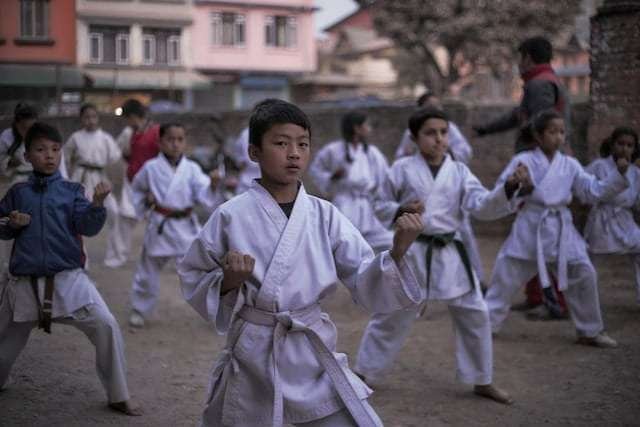Jiu-Jitsu is a traditional Japanese martial art that uses an attacker’s momentum against them rather than directly opposing force with force. For centuries, jiu-jitsu techniques have allowed smaller, weaker practitioners to defend themselves against more significant, vigorous opponents. While jiu-jitsu involves some strikes, the heart of jiu-jitsu is in the grappling techniques – using leverage, angles, and timing to control and submit an opponent.
In recent decades, jiu-jitsu has become increasingly popular worldwide thanks to the rise of mixed martial arts competitions like the UFC. But beyond sports, jiu-jitsu is a highly effective system for realistic self-defense. The techniques teach awareness, control, and efficiency – skills that can help anyone improve their safety in everyday life.
Physical Skills for Self-Defense
Jiu-jitsu is sometimes called “gentle art” because it emphasizes skill over strength. By training in these martial arts techniques, students develop several physical abilities invaluable for self-defense:
Grappling Ability
Jiu-jitsu heavily emphasizes ne-waza or ground grappling techniques. Students learn a variety of positions, transitions, submissions, and escapes that give them an unparalleled ability to control an opponent on the ground. These skills allow a martial art practitioner to neutralize threats from larger, stronger attackers.
Technical Knowledge
In addition to strength, jiu-jitsu relies on detailed technical knowledge. Advanced students learn hundreds of techniques for tilting, off-balancing, leveraging, sweeping, reversing, and pinning their training partners. This specialized repository prepares students to quickly adapt their defense regardless of the attacker’s strength and skill level.
Physical Conditioning
Jiu-jitsu training provides an intensive full-body workout focused on functional strength and flexibility. Students develop cardiovascular fitness, core strength, grip strength, and reflexes. This physical conditioning gives them the endurance to defend themselves effectively, even under duress.
Mental Skills for Self-Defense
Beyond physical techniques, long-term jiu-jitsu practice also instills invaluable mental and emotional abilities for self-defense:
Situational Awareness
The very nature of grappling requires close attention to balance, leverage, and opponent movement. Students naturally develop keen situational awareness that allows them to quickly sense and react to evolving threats. This awareness makes them less likely to be taken by surprise.
Calm Under Pressure
Jiu-jitsu sparring against fully resisting partners prepares students to perform techniques effectively under intense pressure. Regular training inoculates students against the adrenaline and panic that can cloud judgment in violent encounters.
Confidence
After extended jiu-jitsu training, students carry themselves with increased confidence – not aggression or arrogance. This quiet confidence comes from proven experience overcoming larger resisting opponents regardless of relative size and gender. They know their training will serve them well if needed.
Integrating Skills Into Everyday Life
While dedicated training is required to achieve jiu-jitsu’s full benefits, specific principles, and strategies can boost safety in everyday situations:
Avoid Potential Threats
Jiu-jitsu practitioners learn to use environmental awareness, positioning, and de-escalation to avoid physical confrontation whenever possible. Apply these same strategies to steer clear of dangerous places and people.
Don’t Resist Directly
If forced to engage a threatening person, don’t forcefully resist their actions. Instead, they use body movement and redirection of motion to disrupt their balance-core jiu-jitsu principles. Where direct resistance fails, subtle disruption may create openings.
Target Vulnerabilities
Jiu-jitsu students intimately know the human body’s anatomical weaknesses. If the situation escalates to physical defense, use the minimum necessary force aimed precisely at vulnerable points to neutralize the threat efficiently.
Stay Calm and Clear-Headed
Stress reactions and panic are as dangerous as any external threat. Use deep breathing and tactical thinking to override the adrenaline response. Assess the situation and respond decisively rather than lashing out unthinkingly.
A Lifetime of Benefits
Jiu-jitsu is a profound practice requiring extensive time and effort to achieve mastery. But integrating even basic jiu-jitsu principles into your life immediately boosts awareness, confidence, and capability to handle violence. Consistent training provides lifelong benefits by ingraining instinctive defensive skills and combative fitness.
With jiu-jitsu’s well-rounded physical and mental lessons, practitioners develop a calm self-assurance and ability to defuse conflict that serves them well on and off the training mats.
Conclusion:
Jiu-jitsu is more than just a sport – it is a practical self-defense system with benefits extending far beyond the dojo. By cultivating awareness, control, and adaptability, this martial art allows smaller and weaker individuals to handle larger aggressive attackers effectively. The physical techniques and mental attributes both developed through regular jujutsu martial arts practice enhance personal safety in all areas of daily life.
While violence should always be avoided when possible, jiu-jitsu offers skills to differentiate between being a victim or walking away unharmed. With its blend of athleticism, mindfulness, and self-mastery, jiu-jitsu provides a lifetime of advantages for confidently facing the world.









